Vehicular PM Emissions and Urban Public Health Sustainability: A Probabilistic Analysis for Dhaka City
Abstract
1. Introduction
2. Methodology
2.1. Probabilistic PM2.5 Emissions Assessment
2.1.1. Modelling Data
2.1.2. Estimating On-Road PM2.5 Concentrations
- ○
- The required meteorological data [82] were obtained from the Bangladesh Bureau of Meteorology [86]. CALINE4 was simulated for the dry season of the year (November–March), as the rate of deposition is lower during this period [32]. Thus, having a higher concentration scenario would allow planning for the worst-case scenarios. The meteorological data are provided in Figure 3, showing an east–west movement of the wind (Figure 3b) stimulating the east–west dispersion of pollutants. The model was run for December assuming to be applicable for dry months.
- ○
- The average concentration of peak and off-peak periods was estimated separately by running the model for 1 h for each period. The 1-h average is considered representative as the stochastic modelling generated the average for each period by considering the highest and lowest values.
- ○
- The model was run without considering any background PM2.5 concentration so that it can predict the concentration resulted from vehicular sources only.
2.2. Probability of Emissions/Risks
2.3. Risk Analysis
- The severity was classified in this research considering the magnitude of emissions compared to the threshold (standard) level, which is 65 µg/m3 (hourly average) for PM2.5 as per Bangladesh standard [58].
- ○
- Very severe—5: hourly emission concentration > 278 µg/m3 = AQI 200 – 300 (extremely unhealthy air quality);
- ○
- Severe—4: hourly emissions concentration > 102 µg/m3 = AQI 150 – 200 (unhealthy air quality);
- ○
- Critical—3: hourly emissions concentration > 65 µg/m3 = AQI 100 – 150 (unhealthy air quality for sensitive groups);
- ○
- Marginal—2: emissions concentration ≤ 65 µg/m3 = AQI 50 – 100 (moderate air quality);
- ○
- Negligible—1: emissions concentration < 22 µg/m3 = AQI 0 – 50 (good air quality).
- The probability of exceeding the threshold level was classified based on the percentage of probability. A general rule of scaling the probability practised in project management [87,88] was adopted for this research, which was in line with the previous research conducted on NOx probability analysis [82]; viz., probability ≥ 80% = Strong (scale 5), 60–80% = High (scale 4), 40–60% = Medium (scale 3), 10–40% = Low (scale 2), and < 10% = improbable (scale 1).
2.4. Spatial Distribution of Emissions/Risks
3. Results and Discussions
3.1. Emissions and Their Probability
3.2. Risk Severity from Particulate Pollution
4. Conclusions
Author Contributions
Funding
Conflicts of Interest
References
- Roy, S.; Sowgat, T.; Mondal, J. City Profile: Dhaka, Bangladesh. Environ. Urban. ASIA 2019, 10, 216–232. [Google Scholar] [CrossRef]
- WAQI. Air Pollution: Real-Time Air Quality Index (AQI). 2020. Available online: https://aqicn.org/city/bangladesh/dhaka/us-consulate/ (accessed on 1 May 2020).
- Yang, H.H.; Arafath, S.M.; Lee, K.T.; Hsieh, Y.S.; Han, Y.T. Chemical characteristics of filterable and condensable PM2.5 emissions from industrial boilers with five different fuels. Fuel 2018, 232, 415–422. [Google Scholar] [CrossRef]
- Hama, S.M.L.; Kumar, P.; Harrison, R.M.; Bloss, W.J.; Khare, M.; Mishra, S.; Namdeo, A.; Sokhi, R.; Goodman, P.; Sharma, C. Four-year assessment of ambient particulate matter and trace gases in the Delhi-NCR region of India. Sustain. Cities Soc. 2020, 54, 102003. [Google Scholar] [CrossRef]
- Wu, J.Z.; Ge, D.D.; Zhou, L.F.; Hou, L.Y.; Zhou, Y.; Li, Q.Y. Effects of particulate matter on allergic respiratory diseases. Chronic Dis. Transl. Med. 2018, 4, 95–102. [Google Scholar] [CrossRef]
- Karakatsani, A.; Analitis, A.; Perifanou, D.; Ayres, J.G.; Harrison, R.M.; Kotronarou, A.; Kavouras, I.G.; Pekkanen, J.; Hämeri, K.; Kos, G.P.; et al. Particulate matter air pollution and respiratory symptoms in individuals having either asthma or chronic obstructive pulmonary disease: A European multicentre panel study. Environ. Health 2012, 11, 75. [Google Scholar] [CrossRef]
- Pani, S.K.; Chantara, S.; Khamkaew, C.; Lee, C.T.; Lin, N.H. Biomass burning in the northern peninsular Southeast Asia: Aerosol chemical profile and potential exposure. Atmos. Res. 2019, 224, 180–195. [Google Scholar] [CrossRef]
- BTRE. Health Impacts of Transport Emissions in Australia: Economic Costs; Bureau of Transport and Regional Economics: Canberra, Australia, 2005.
- WHO. Health Effects of Transport-Related Air Pollution: Summary for Policy Makers; WHO Regional Office for Europe: Geneva, Switzerland, 2005. [Google Scholar]
- Cheng, Z.; Jiang, J.; Fajardo, O.; Wang, S.; Hao, J. Characteristics and health impacts of particulate matter pollution in China (2001–2011). Atmos. Environ. 2013, 65, 186–194. [Google Scholar] [CrossRef]
- Guttikunda, S.K.; Kopakka, R.V. Source emissions and health impacts of urban air pollution in Hyderabad, India. Air Qual. Atmos. Health 2014, 7, 195–207. [Google Scholar] [CrossRef]
- Guttikunda, S.K.; Goel, R. Health impacts of particulate pollution in a megacity—Delhi, India. Environ. Dev. 2013, 6, 8–20. [Google Scholar] [CrossRef]
- Brugha, R.; Grigg, J. Urban air pollution and respiratory infections. Paediatr. Respir. Rev. 2014, 15, 194–199. [Google Scholar] [CrossRef]
- Kelly, F.J.; Fussell, J.C. Air pollution and public health: Emerging hazards and improved understanding of risk. Environ. Geochem. Health 2015, 37, 631–649. [Google Scholar] [CrossRef] [PubMed]
- Cohen, A.J.; Brauer, M.; Burnett, R.; Anderson, H.R.; Frostad, J.; Estep, K.; Balakrishnan, K.; Brunekreef, B.; Dandona, L.; Dandona, R.; et al. Estimates and 25-year trends of the global burden of disease attributable to ambient air pollution: An analysis of data from the Global Burden of Diseases Study 2015. Lancet 2017, 389, 1907–1918. [Google Scholar] [CrossRef]
- De Miranda, R.M.; Andrade, M.d.; Fornaro, A.; Astolfo, R.; de Andre, P.A.; Saldiva, P. Urban air pollution: A representative survey of PM2.5 mass concentrations in six Brazilian cities. Air Qual. Atmos. Health 2012, 5, 63–77. [Google Scholar] [CrossRef]
- Janssen, N.A.H.; Hoek, G.; Simic-Lawson, M.; Fischer, P.; van Bree, L.; Brink, H.T.; Keuken, M.; Atkinson, R.W.; Anderson, H.R.; Brunekreef, B.; et al. Black Carbon as an Additional Indicator of the Adverse Health Effects of Airborne Particles Compared with PM10 and PM2.5. Environ. Health Perspect. 2011, 119, 1691–1699. [Google Scholar] [CrossRef] [PubMed]
- Chuang, K.J.; Yan, Y.H.; Chiu, S.Y.; Cheng, T.J. Long-term air pollution exposure and risk factors for cardiovascular diseases among the elderly in Taiwan. Occup. Environ. Med. 2011, 68, 64–68. [Google Scholar] [CrossRef] [PubMed]
- Grahame, T.J.; Klemm, R.; Schlesinger, R.B. Public health and components of particulate matter: The changing assessment of black carbon. J. Air Waste Manag. Assoc. 2014, 64, 620–660. [Google Scholar] [CrossRef] [PubMed]
- WCED, Our common future. UN World Commission on Environment and Development; Oxford University Press: Oxford, UK, 1987; pp. 1–91. [Google Scholar]
- Bentley, M. An ecological public health approach to understanding the relationships between sustainable urban environments, public health and social equity. Health Promot. Int. 2014, 29, 528–537. [Google Scholar] [CrossRef] [PubMed]
- Goldman, T.; Gorham, R. Sustainable urban transport: Four innovative directions. Technol. Soc. 2006, 28, 261–273. [Google Scholar] [CrossRef]
- Harpham, T.; Werna, E. Sustainable urban health in developing countries. Habitat Int. 1996, 20, 421–429. [Google Scholar] [CrossRef]
- Holden, E.; Linnerud, K.; Banister, D. Sustainable development: Our Common Future revisited. Glob. Environ. Chang. 2014, 26, 130–139. [Google Scholar] [CrossRef]
- Begum, B.A.; Biswas, S.K.; Markwitz, A.; Hopke, P.K. Identification of sources of fine and coarse particulate matter in Dhaka, Bangladesh. Aerosol Air Qual. Res. 2010, 10, 345–353. [Google Scholar] [CrossRef]
- Begum, B.A.; Hopke, P.K.; Markwitz, A. Air pollution by fine particulate matter in Bangladesh. Atmos. Pollut. Res. 2013, 4, 75–86. [Google Scholar] [CrossRef]
- Begum, B.A.; Hopke, P.K. Ambient air quality in Dhaka Bangladesh over two decades: Impacts of policy on air quality. Aerosol Air Qual. Res. 2018, 18, 1910–1920. [Google Scholar] [CrossRef]
- Mahmood, A.; Hu, Y.; Nasreen, S.; Hopke, P.K. Airborne particulate pollution measured in Bangladesh from 2014 to 2017. Aerosol Air Qual. Res. 2019, 19, 272–281. [Google Scholar] [CrossRef]
- Guttikunda, S.K.; Begum, B.A.; Wadud, Z. Particulate pollution from brick kiln clusters in the Greater Dhaka region, Bangladesh. Air Qual. Atmos. Health 2013, 6, 357–365. [Google Scholar] [CrossRef]
- Haque, M.I.; Nahar, K.; Kabir, M.H.; Salam, A. Particulate black carbon and gaseous emission from brick kilns in Greater Dhaka region, Bangladesh. Air Qual. Atmos. Health 2018, 11, 925–935. [Google Scholar] [CrossRef]
- Begum, B.A.; Hopke, P.K. Identification of sources from chemical characterization of fine particulate matter and assessment of ambient air quality in Dhaka, Bangladesh. Aerosol Air Qual. Res. 2019, 19, 118–128. [Google Scholar] [CrossRef]
- Iqbal, A.; Oanh, N.T.K. Assessment of acid deposition over Dhaka division using CAMx-MM5 modeling system. Atmos. Pollut. Res. 2011, 2, 452–462. [Google Scholar] [CrossRef]
- Bano, S.; Pervez, S.; Chow, J.C.; Matawle, J.L.; Watson, J.G.; Sahu, R.K.; Srivastava, A.; Tiwari, S.; Pervez, Y.F.; Deb, M.K. Coarse particle (PM10–2.5) source profiles for emissions from domestic cooking and industrial process in Central India. Sci. Total Environ. 2018, 627, 1137–1145. [Google Scholar] [CrossRef]
- Rana, M.M.; Sulaiman, N.; Sivertsen, B.; Khan, M.F.; Nasreen, S. Trends in atmospheric particulate matter in Dhaka, Bangladesh, and the vicinity. Environ. Sci. Pollut. Res. 2016, 23, 17393–17403. [Google Scholar] [CrossRef]
- Bluett, J.; Dey, K.; Fisher, G. Assessing Vehicle Air Pollution Emissions; National Institute for Water and Atmospheric Research: Auckland, New Zealand, 2008. [Google Scholar]
- Cao, X.; Yao, Z.; Shen, X.; Ye, Y.; Jiang, X. On-road emission characteristics of VOCs from light-duty gasoline vehicles in Beijing, China. Atmos. Environ. 2016, 124, 146–155. [Google Scholar] [CrossRef]
- Cui, L.; Wang, X.L.; Ho, K.F.; Gao, Y.; Liu, C.; Ho, S.S.H.; Li, H.W.; Lee, S.C.; Wang, X.M.; Jiang, B.Q.; et al. Decrease of VOC emissions from vehicular emissions in Hong Kong from 2003 to 2015: Results from a tunnel study. Atmos. Environ. 2018, 177, 64–74. [Google Scholar] [CrossRef]
- EPA. Vehicle Emissions and Air Quality. 2019. Available online: https://www.epa.vic.gov.au/your-environment/air/vehicle-emissions-and-air-quality (accessed on 14 August 2019).
- Gong, M.; Yin, S.; Gu, X.; Xu, Y.; Jiang, N.; Zhang, R. Refined 2013-based vehicle emission inventory and its spatial and temporal characteristics in Zhengzhou, China. Sci. Total Environ. 2017, 599, 1149–1159. [Google Scholar] [CrossRef] [PubMed]
- Goyal, P.; Mishra, D.; Kumar, A. Vehicular emission inventory of criteria pollutants in Delhi. SpringerPlus 2013, 2, 216. [Google Scholar] [CrossRef] [PubMed]
- Hassler, B.; McDonald, B.C.; Frost, G.J.; Borbon, A.; Carslaw, D.C.; Civerolo, K.; Granier, C.; Monks, P.S.; Monks, S.; Parrish, D.D.; et al. Analysis of long-term observations of NOxand CO in megacities and application to constraining emissions inventories. Geophys. Res. Lett. 2016, 43, 9920–9930. [Google Scholar] [CrossRef]
- Li, B.; Ho, S.S.H.; Xue, Y.; Huang, Y.; Wang, L.; Cheng, Y.; Dai, W.; Zhong, H.; Cao, J.; Lee, S. Characterizations of volatile organic compounds (VOCs) from vehicular emissions at roadside environment: The first comprehensive study in Northwestern China. Atmos. Environ. 2017, 161, 1–12. [Google Scholar] [CrossRef]
- Zhang, S.; Wu, Y.; Liu, H.; Wu, X.; Zhou, Y.; Yao, Z.; Fu, L.; He, K.; Hao, J. Historical evaluation of vehicle emission control in Guangzhou based on a multi-year emission inventory. Atmos. Environ. 2013, 76, 32–42. [Google Scholar] [CrossRef]
- Iqbal, A.; Allan, A.; Zito, R. Meso-scale on-road vehicle emission inventory approach: A study on Dhaka City of Bangladesh supporting the cause-effect’ analysis of the transport system. Environ. Monit. Assess. 2016, 188, 149. [Google Scholar] [CrossRef]
- Zhao, T.; Yang, L.; Huang, Q.; Zhang, W.; Duan, S.; Gao, H.; Wang, W. PM2.5-bound polycyclic aromatic hydrocarbons (PAHs) and nitrated-PAHs (NPAHs) emitted by gasoline vehicles: Characterization and health risk assessment. Sci. Total Environ. 2020, 727, 138631. [Google Scholar] [CrossRef]
- Singh, V.; Biswal, A.; Kesarkar, A.P.; Mor, S.; Ravindra, K. High resolution vehicular PM10 emissions over megacity Delhi: Relative contributions of exhaust and non-exhaust sources. Sci. Total Environ. 2020, 699, 134273. [Google Scholar] [CrossRef]
- Papadopoulos, G.; Ntziachristos, L.; Tziourtzioumis, C.; Keramydas, C.; Lo, T.S.; Ng, K.L.; Wong, H.L.A.; Wong, C.K.-L. Real-world gaseous and particulate emissions from Euro IV to VI medium duty diesel trucks. Sci. Total Environ. 2020, 731, 139137. [Google Scholar] [CrossRef] [PubMed]
- Pant, P.; Harrison, R.M. Estimation of the contribution of road traffic emissions to particulate matter concentrations from field measurements: A review. Atmos. Environ. 2013, 77, 78–97. [Google Scholar] [CrossRef]
- Mitchell, R.; Maher, B.A. Evaluation and application of biomagnetic monitoring of traffic-derived particulate pollution. Atmos. Environ. 2009, 43, 2095–2103. [Google Scholar] [CrossRef]
- Li, Y.; Xiang, R. Particulate pollution in an underground car park in Wuhan, China. Particuology 2013, 11, 94–98. [Google Scholar] [CrossRef]
- Lawrence, S.; Sokhi, R.; Ravindra, K. Quantification of vehicle fleet PM 10 particulate matter emission factors from exhaust and non-exhaust sources using tunnel measurement techniques. Environ. Pollut. 2016, 210, 419–428. [Google Scholar] [CrossRef]
- Kontses, A.; Ntziachristos, L.; Zardini, A.A.; Papadopoulos, G.; Giechaskiel, B. Particulate emissions from L-Category vehicles towards Euro 5. Environ. Res. 2020, 182, 109071. [Google Scholar] [CrossRef]
- Ketzel, M.; Omstedt, G.; Johansson, C.; Düring, I.; Pohjola, M.; Oettl, D.; Gidhagen, L.; Wåhlin, P.; Lohmeyer, A.; Haakana, M.; et al. Estimation and validation of PM2.5/PM10 exhaust and non-exhaust emission factors for practical street pollution modelling. Atmos. Environ. 2007, 41, 9370–9385. [Google Scholar] [CrossRef]
- Al-Thani, H.; Koç, M.; Fountoukis, C.; Isaifan, R.J. Evaluation of particulate matter emissions from non-passenger diesel vehicles in Qatar. J. Air Waste Manag. Assoc. 2020, 70, 228–242. [Google Scholar] [CrossRef]
- Andreão, W.L.; Alonso, M.F.; Kumar, P.; Pinto, J.A.; Pedruzzi, R.; De Almeida Albuquerque, T.T. Top-down vehicle emission inventory for spatial distribution and dispersion modeling of particulate matter. Environ. Sci. Pollut. Res. 2020. [Google Scholar] [CrossRef]
- Huy, L.N.; Oanh, N.T.K.; Htut, T.T.; Hlaing, O.M.T. Emission inventory for on-road traffic fleets in Greater Yangon, Myanmar. Atmos. Pollut. Res. 2020, 11, 702–713. [Google Scholar] [CrossRef]
- WHO. WHO Air Quality Guidelines for Particulate Matter, Ozone, Nitrogen Dioxide and Sulfur Dioxide; World Health Organization: Geneva, Switzerland, 2006. [Google Scholar]
- DoE. Ambient air quality in Bangladesh. In Clean Air and Sustainable Environment Project; Department of Environment: Dhaka, Bangladesh, 2018. [Google Scholar]
- EPA. Air Quality Index: A Guide to Air Quality and Your Health; U.S. Environmental Protection Agency: Washington, DC, USA, 2014.
- IQAir. Explore the Air Quality: Live City Ranking. 2020. Available online: https://www.iqair.com/ (accessed on 14 May 2020).
- BRTA. Registered Vehicles in Dhaka: Statistics. 2020. Available online: www.brta.gov.bd (accessed on 19 January 2020).
- DTCB. BRT and Corridor Restructuring Implementation Study and Preliminary Design Work for the Uttara-Mohakhali-Ramna-Sadarghat Corridor in Dhaka: Interim Report; Dhaka Transport Coordination Board: Dhaka, Bangladesh, 2011.
- Rahman, M.M.; Hoque, S.M.A.; Zaber, M.I. Understanding real time traffic characteristics of urban zones using GPS data: A computational study on Dhaka City. In Proceedings of the 2018 Joint 7th International Conference on Informatics, Electronics & Vision (ICIEV) and 2018 2nd International Conference on Imaging, Vision & Pattern Recognition (icIVPR), Kitakyushu, Japan, 25–28 June 2018; pp. 514–519. [Google Scholar]
- EEA. EMEP/EEA Air Pollutant Emission Inventory Guidebook; European Environment Agency: Luxembourg, 2009. [Google Scholar]
- Rahman, M.M.; Jahan, J.; Zhou, Y. Alleviating traffic congestion by the strategy of modal shift from private cars to public transports: A case of Dhaka City, Bangladesh. In Proceedings of the 2018 Conference of the Computational Social Science Society of the Americas, Santa Fe, NM, USA, 25–28 October 2018; Springer International Publishing: Cham, Switzerland, 2020. [Google Scholar]
- Iqbal, A.; Allan, A.; Afroze, S. Analysis of transport eco-efficiency scenarios to support sustainability assessment: A study on Dhaka City, Bangladesh. Environ. Monit. Assess. 2017, 189, 366. [Google Scholar] [CrossRef] [PubMed]
- Rahman, M.M.; Shuvo, M.M.M.; Zaber, M.I.; Ali, A.A. Traffic pattern analysis from gps data: A case study of Dhaka City. In Proceedings of the 2018 IEEE International Conference on Electronics, Computing and Communication Technologies (CONECCT), Bangalore, India, 16–17 March 2018. [Google Scholar]
- Noor, R.E.; Imran, M.; Hossain, M.I. A brief study on capacity loss at major Dhaka City roads. Int. J. Transp. Eng. Technol. 2016, 2, 1–7. [Google Scholar]
- Abdullah, S.; Mansor, A.A.; Napi, N.N.L.M.; Mansor, W.N.W.; Ahmed, A.N.; Ismail, M.; Ramly, Z.T.A. Air quality status during 2020 Malaysia Movement Control Order (MCO) due to 2019 novel coronavirus (2019-nCoV) pandemic. Sci. Total Environ. 2020, 729, 139022. [Google Scholar] [CrossRef] [PubMed]
- Otmani, A.; Benchrif, A.; Tahri, M.; Bounakhla, M.; Chakir, E.M.; el Bouch, M.; Krombi, M.H. Impact of Covid-19 lockdown on PM10, SO2 and NO2 concentrations in Salé City (Morocco). Sci. Total Environ. 2020, 735, 139541. [Google Scholar] [CrossRef] [PubMed]
- Wang, Y.; Yuan, Y.; Wang, Q.; Liu, C.; Zhi, Q.; Cao, J. Changes in air quality related to the control of coronavirus in China: Implications for traffic and industrial emissions. Sci. Total Environ. 2020, 731, 139133. [Google Scholar] [CrossRef] [PubMed]
- Cheng, S.; Lu, F.; Peng, P. A high-resolution emissions inventory and its spatiotemporal pattern variations for heavy-duty diesel trucks in Beijing, China. J. Clean. Prod. 2020, 250, 119445. [Google Scholar] [CrossRef]
- Oanh, N.T.K.; Upadhyay, N.; Zhuang, Y.H.; Hao, Z.P.; Murthy, D.V.S.; Lestari, P.; Villarin, J.T.; Chengchua, K.; Co, H.X.; Dung, N.T.; et al. Particulate air pollution in six Asian cities: Spatial and temporal distributions, and associated sources. Atmos. Environ. 2006, 40, 3367–3380. [Google Scholar] [CrossRef]
- Wei, T.; Frey, H.C. Factors affecting variability in fossil-fueled transit bus emission rates. Atmos. Environ. 2020, 233, 117613. [Google Scholar] [CrossRef]
- Requia, W.J.; Arain, A.; Koutrakis, P.; Dalumpines, R. Assessing particulate matter emissions from future electric mobilityand potential risk for human health in Canadian metropolitan area. Air Qual. Atmos. Health 2018, 11, 1009–1019. [Google Scholar] [CrossRef]
- Padoan, E.; Ajmone-Marsan, F.; Querol, X.; Amato, F. An empirical model to predict road dust emissions based on pavement and traffic characteristics. Environ. Pollut. 2018, 237, 713–720. [Google Scholar] [CrossRef]
- Panko, J.; Hitchcock, K.; Fuller, G.; Green, D. Evaluation of Tire Wear Contribution to PM2.5 in Urban Environments. Atmosphere 2019, 10, 99. [Google Scholar] [CrossRef]
- Park, I.; Kim, H.; Lee, S. Characteristics of tire wear particles generated in a laboratory simulation of tire/road contact conditions. J. Aerosol Sci. 2018, 124, 30–40. [Google Scholar] [CrossRef]
- Penkała, M.; Ogrodnik, P.; Rogula-Kozłowska, W. Particulate Matter from the Road Surface Abrasion as a Problem of Non-Exhaust Emission Control. Environments 2018, 5, 9. [Google Scholar] [CrossRef]
- Frey, H.C.; Zheng, J. Probabilistic Analysis of Driving Cycle-Based Highway Vehicle Emission Factors. Environ. Sci. Technol. 2002, 36, 5184–5191. [Google Scholar] [CrossRef]
- O’ Ryan, R.; Benavides, C.; Díaz, M.; Martín, J.P.S.; Mallea, J. Using probabilistic analysis to improve greenhouse gas baseline forecasts in developing country contexts: The case of Chile. Clim. Policy 2019, 19, 299–314. [Google Scholar] [CrossRef]
- Iqbal, A.; Afroze, S.; Rahman, M.M. Probabilistic health risk assessment of vehicular emissions as an urban health indicator in Dhaka city. Sustainability 2019, 11, 6427. [Google Scholar] [CrossRef]
- Iqbal, A.; Allan, A. Modelling eco-effciency for vehicular emissions from the perspective of Dhaka city: Development of a tool for sustainable transport planning. In Proceedings of the 14th International Conference on Computers in Urban Planning and Urban Management, Massachusetts Institute of Technology (MIT), Cambridge, MA USA, 7–10 July 2015; MIT: Cambridge, MA, USA, 2015. Available online: http://web.mit.edu/cron/project/CUPUM2015/proceedings/Content/modeling/260_iqbal_h.pdf (accessed on 26 March 2020).
- USEPA. Preferred Dispersion Models. 2019. Available online: https://www.epa.gov/scram/air-quality-dispersion-modeling-preferred-and-recommended-models (accessed on 18 February 2019).
- CL4, User’s guide for cl4: A user friendly interface for the caline4 model for transportation project impact assessments. In California Line Source Dispersion Model Version 4 (CALINE4); California Department of Transportation: Sacramento, CA, USA, 1998.
- BMD. Statistics, G.o.B; Bangladesh Meteorological Department: Dhaka, Bangladesh, 2019.
- Garvey, P.R. Track 2: Implementing a Risk Management Process for a Large Scale Information System Upgrade—A Case Study. Insight 2001, 4, 15–22. [Google Scholar] [CrossRef]
- ACS. Risk Rating and Assessment. 2019. Available online: https://www.acs.org/content/acs/en/chemical-safety/hazard-assessment/fundamentals/risk-assessment.html (accessed on 24 June 2019).
- DoE. Revisions of vehicular emission standards for Bangladesh. In Clean Air and Sustainable Environment Project; Department of Environment: Dhaka, Bangladesh, 2012. [Google Scholar]

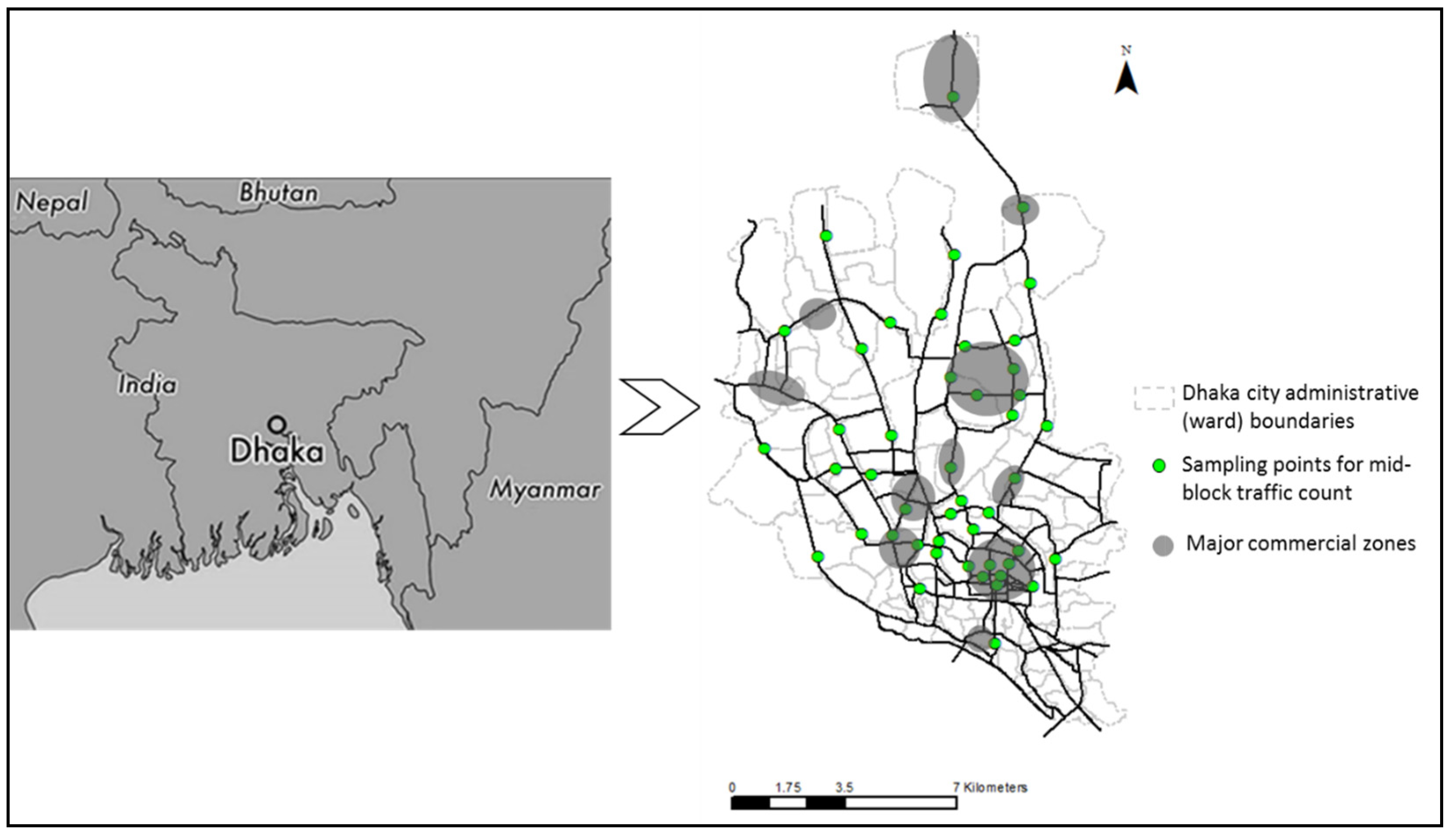

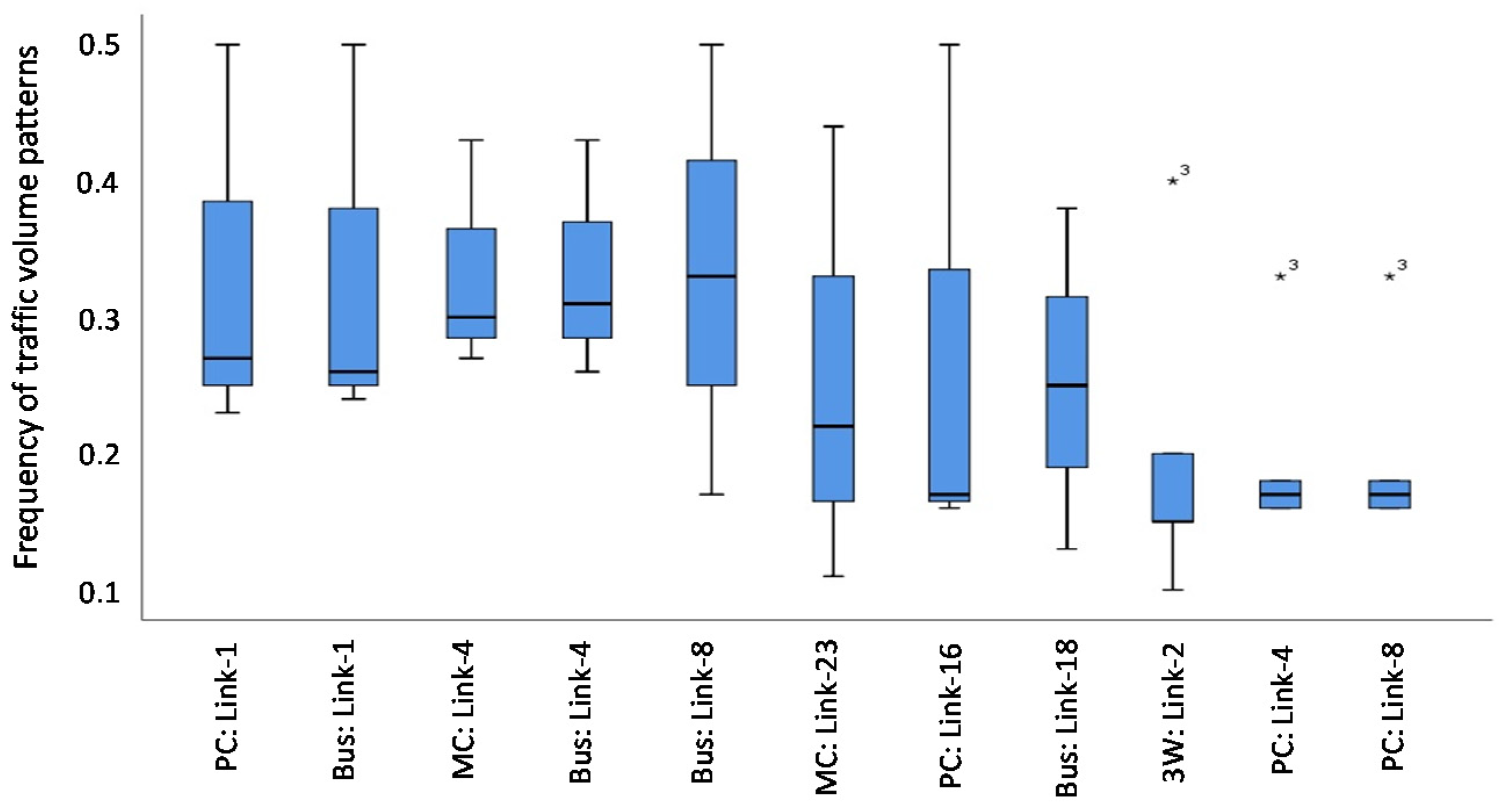
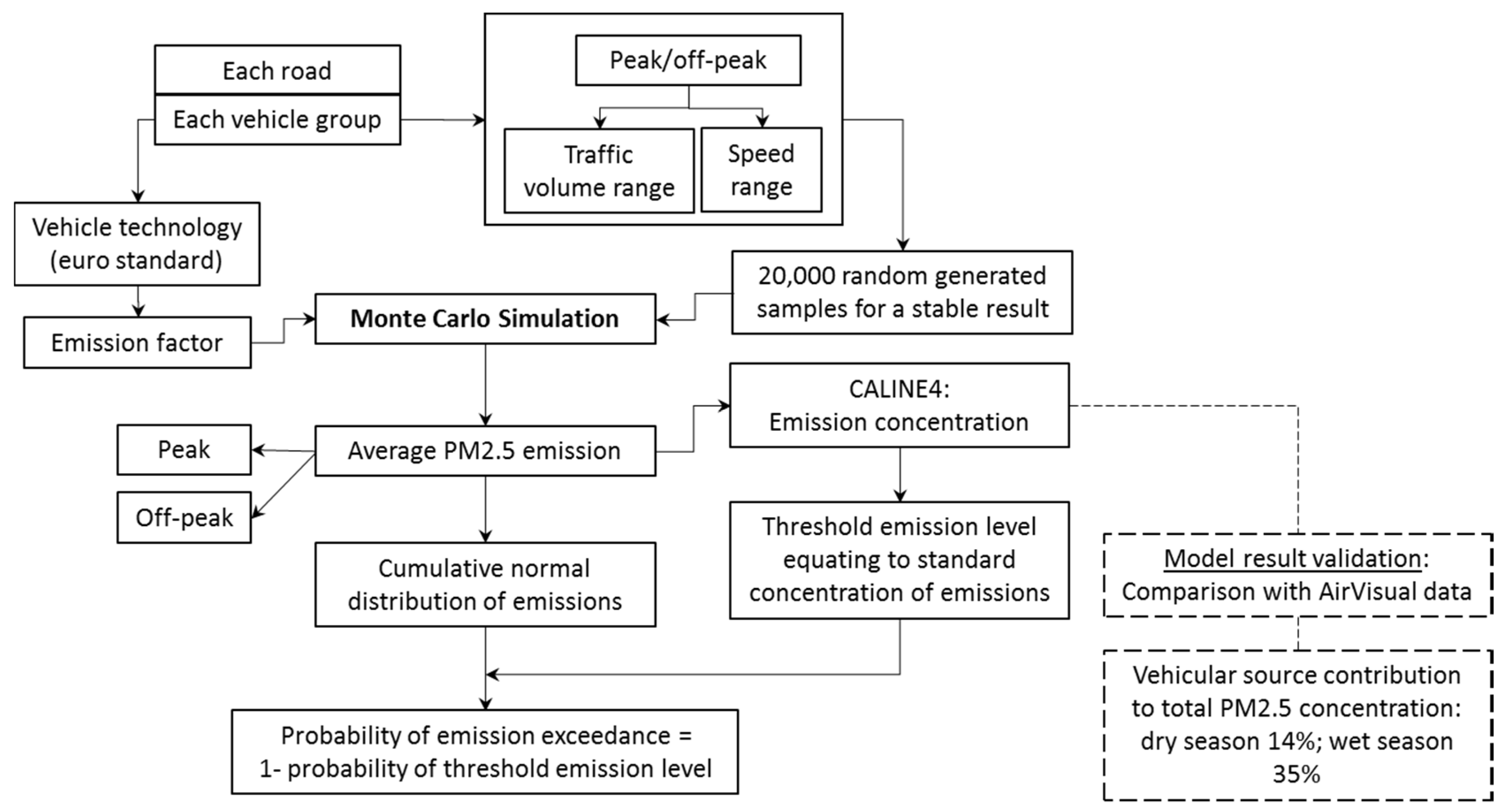
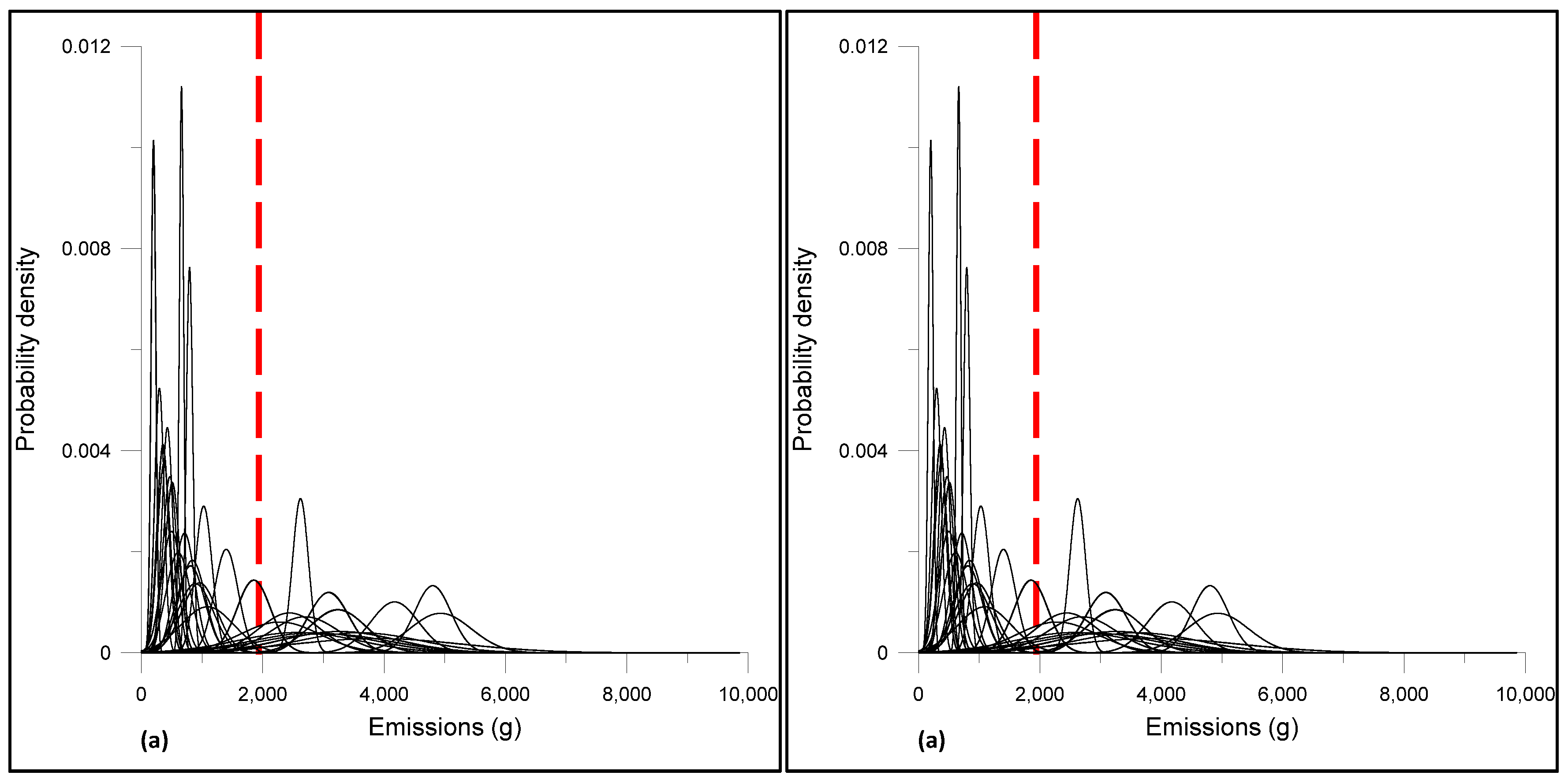


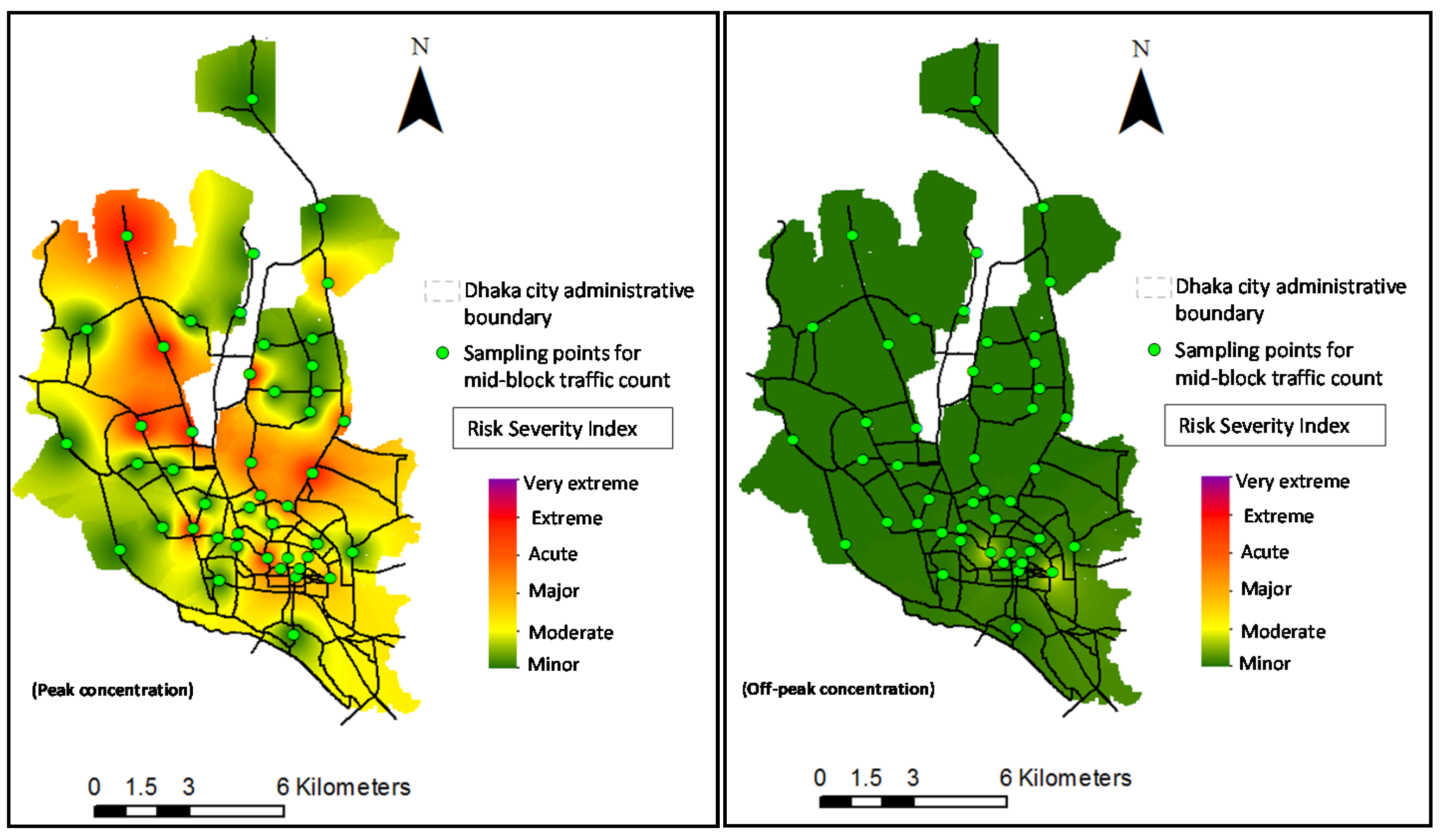
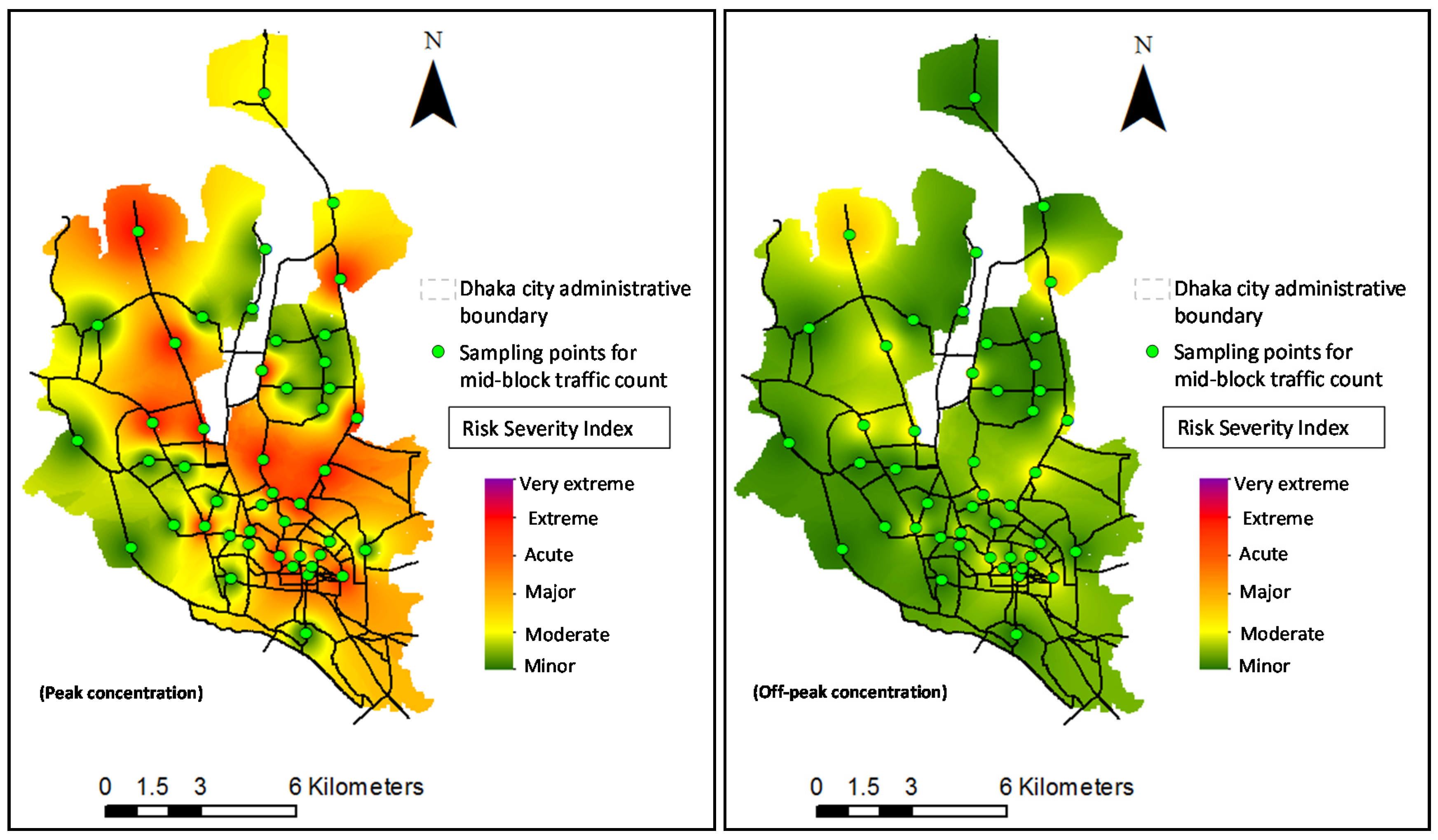

| PM2.5 Emissions (mg/g of Fuel) | |
|---|---|
| Gasoline | |
| Passenger Car (Euro 2/Euro 4) | |
| < 1.4 L | 1.125/0.02 |
| 1.4−2.0 L | 0.985/0.017 |
| > 2.0 L | 0.844/0.013 |
| LDV (Conventional/Euro 4) | 0.844/0.011 |
| MC ( > 50 cc) (Euro 2/Euro 4) | 7.032/0.097 |
| Diesel | |
| LDV (conventional/Euro 3) | 5.889/0.879 |
| Truck < 7.5 t (Euro 1/Euro 3) | 7.853/0.453 |
| Bus—urban midi (Euro 1/Euro 3) | 3.926/0.566 |
| CNG | |
| Passenger Car (Euro 2/Euro 4) (all capacities) | 0.21/0 |
| LDV ( > 2.0 L) (Euro 2/Euro 4) | 0.18/0 |
| HDV bus (Euro 4) | 0.018 |
| 3W ( < 1.4 L) (Euro 2/Euro 4) | 0.21/0 |
| Probability | Severity | ||||
|---|---|---|---|---|---|
| Very Severe—5 | Severe—4 | Critical—3 | Marginal—2 | Negligible—1 | |
| Strong—5 | Very extreme (25) | Extreme (20) | Acute (15) | Major (10) | Minor (5) |
| High—4 | Extreme (20) | Acute (16) | Major (12) | Modest (8) | Minor (4) |
| Medium—3 | Acute (15) | Major (12) | Modest (9) | Modest (6) | Minor (3) |
| Low—2 | Major (10) | Modest (8) | Modest (6) | Minor (4) | Minor (2) |
| Improbable—1 | Minor (5) | Minor (4) | Minor (3) | Minor (2) | Minor (1) |
© 2020 by the authors. Licensee MDPI, Basel, Switzerland. This article is an open access article distributed under the terms and conditions of the Creative Commons Attribution (CC BY) license (http://creativecommons.org/licenses/by/4.0/).
Share and Cite
Iqbal, A.; Afroze, S.; Rahman, M.M. Vehicular PM Emissions and Urban Public Health Sustainability: A Probabilistic Analysis for Dhaka City. Sustainability 2020, 12, 6284. https://doi.org/10.3390/su12156284
Iqbal A, Afroze S, Rahman MM. Vehicular PM Emissions and Urban Public Health Sustainability: A Probabilistic Analysis for Dhaka City. Sustainability. 2020; 12(15):6284. https://doi.org/10.3390/su12156284
Chicago/Turabian StyleIqbal, Asif, Shirina Afroze, and Md. Mizanur Rahman. 2020. "Vehicular PM Emissions and Urban Public Health Sustainability: A Probabilistic Analysis for Dhaka City" Sustainability 12, no. 15: 6284. https://doi.org/10.3390/su12156284
APA StyleIqbal, A., Afroze, S., & Rahman, M. M. (2020). Vehicular PM Emissions and Urban Public Health Sustainability: A Probabilistic Analysis for Dhaka City. Sustainability, 12(15), 6284. https://doi.org/10.3390/su12156284






